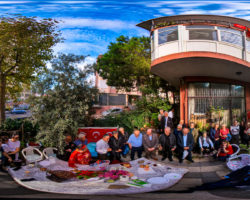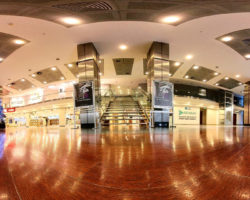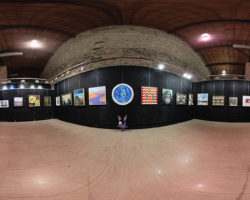Sultan Ahmet Camii, 1609-1616 yılları arasında sultan I. Ahmet tarafından İstanbul’daki tarihi yarımadada, Mimar Sedefkâr Mehmet Ağa’ya yaptırılmıştır. Cami Mavi, yeşil ve beyaz renkli İznik çinileriyle bezendiği için ve yarım kubbeleri ve büyük kubbesinin içi de gene mavi ağırlıklı kalem işleri ile süslendiği için Avrupalılarca “Mavi Cami (Blue Mosque)” olarak adlandırılır. Ayasofya’nın 1934 yılında camiden müzeye dönüştürülmesiyle, İstanbul’un ana camisi konumuna ulaşmıştır. Aslında Sultan Ahmet Camisi külliyesiyle birlikte, İstanbul’daki en büyük yapı komplekslerinden biridir. Bu külliye bir cami, medreseler, hünkar kasrı, arasta, dükkânlar, hamam, çeşme, sebiller, türbe, darüşşifa, sıbyan mektebi, imarethane ve kiralık odalardan oluşmaktadır. Bu yapıların bir kısmı günümüze ulaşamamıştır.
Yapının mimari ve sanatsal açıdan dikkate sayan en önemli yanı, 20.000’i aşkın İznik çinisiyle bezenmesidir. Bu çinilerin süslemelerinde sarı ve mavi tonlardaki geleneksel bitki motifleri kullanılmış, yapıyı sadece bir ibadethane olmaktan öteye taşımıştır. Caminin ibadethane bölümü 64 x 72 metre boyutlarındadır. 43 metre yüksekliğindeki merkezi kubbesinin çapı 23,5 metredir. Caminin içi 260 pencereyle aydınlatılmıştır. Yazıları Diyarbakırlı Seyyid Kasım Gubarî tarafından yazılmıştır. Çevresindeki yapılarla birlikte bir külliye oluşturur ve Sultanahmet, Türkiye’nin altı minareli ilk camisidir.
Altı Minarenin Hikayesi
Efsaneye göre dönemin padişahı I. Ahmet, başta minareleri altından yaptırmak istemiştir. Ama kaplamada kullanılacak olan altının değeri padişahın bütçesini fazlasıyla aşınca, caminin mimarı Sedefkar Mehmet Ağa bu emri güya yanlış işiterek, “altın” sözcüğünden “altı” yaparak, camiyi 6 minareli inşa ettirmiştir.
Ancak efsaneler bir kenara, İstanbul’da meydana gelen her büyük olay, her büyük eser, İslam dünyasını yakından ilgilendiriyor ve başlıca konu ediliyordu. Sultan Ahmet Camisi’nin yapılması da hayranlıklar, geniş yankılar uyandırmıştı. Fakat İmparatorluğun bazı eyaletlerinden de itirazlar gelmişti. İtiraz edenler, camiye altı minare yapılması kabe’ye saygısızlık olur diyorlardi. Çünkü o zamanlar altı minaresi olan tek mabed Mekke’de idi. Padişah bu meseleyi bütün İslam alemini memnun edecek bir şekilde halletti: Mekke’ye yedinci minareyi yaptirdi.
Sultan Ahmet Camisi’nin 1895 yılındaki hali
Minarelerle alakalı diğer bir husus da, şerefelerdir. Sultanahmet minarelerinin dördü üçer, ikisi de ikişer şerefelidir ve toplam 16 şerefe yapmaktadır ki bu da aynı zamanda Sultan Ahmet’in 16. padişah olduğuna işaret eder. Sultan 1. Ahmed 14. padişah olmasına rağmen aradaki fark Osmanlı Devleti’nin Fetret Devri’ndeki Yıldırım Beyazıt’ın iki oğlu Emir Süleyman ve Musa Çelebi’nin tahta geçmemesine karşın padişah sayılmasındandır.
Caminin içeriye açılan 3 kapısından herhangi birinden girildiğinde dış görünüşü tamamlayan boyama, çini ve vitray camlarının zengin ve renkli süslemeleri ile karşılaşılır. İç mekan büyük bir bütündür; ana ve yan kubbeler geniş sivri kemerlerin dayandığı 4 iri sütun üzerinde yükselir. Caminin içini 3 taraftan çevreleyen balkonların duvarları, yine iznik çinileri ile süslüdür. Bunların yukarısı ve bütün kubbe içleri ise boya işidir. Avlunun batı girişinde ise, demirden ağır bir kordon bulunmaktadır. Bu kordon avluya atıyla giren padişahın kafasını çarpmaması için eğmesini gerektiriyordu. Bu, padişahın bile camiye girerken kendisine çeki düzen vermesi gerektiğini göstermek amaçlı sembolik bir eylemdi.
“Sultan Ahmet Camii.” Wikipedia, Özgür Ansiklopedi. 2 Kas 2009, 03:45 UTC. 2 Kas 2009, 22:33 <http://tr.wikipedia.org/w/index.php?title=Sultan_Ahmet_Camii&oldid=6668521>.
————————————————————————————————————————————————————————
ENGLISH
The Sultan Ahmed Mosque (Turkish: Sultanahmet Camii; is a historical mosque in Istanbul, the largest city in Turkey and the capital of the Ottoman Empire (from 1453 to 1923). The mosque is popularly known as the Blue Mosque for the blue tiles adorning the walls of its interior.
It was built between 1609 and 1616, during the rule of Ahmed I. Like many other mosques, it also comprises a tomb of the founder, a madrasah and a hospice. While still used as a mosque, the Sultan Ahmed Mosque has also become a popular tourist attraction.
History
The old Hippodrome of Constantinople with the Blue Mosque on the left side. Painting by Jean-Baptiste van Mour, first half of 18th century.
Old photo of the Blue Mosque, taken before 1895.
After the Peace of Zsitvatorok and the unfavourable result of the wars with Persia, Sultan Ahmed I decided to build a large mosque in Istanbul to placate Allah. This would be the first imperial mosque to be built in more than forty years. Whereas his predecessors had paid for their mosques with their war booty, Sultan Ahmed I had to withdraw the funds from the treasury, because he had not won any notable victories. This provoked the anger of the ulema, the Muslim legal scholars.
The mosque was to be built on the site of the palace of the Byzantine emperors, facing the Hagia Sophia (at that time the most venerated mosque in Istanbul) and the hippodrome, a site of great symbolic significance. Large parts of the southern side of the mosque rest on the foundation and vaults of the Great Palace. Several palaces had already built there, most notably the palace of Sokollu Mehmet Paşa, so these first had to be bought at a considerable cost and pulled down. Large parts of the Sphendone (curved tribune with U-shaped structure of the hippodrome) were also removed to make room for the new mosque.
Construction of the mosque started in August 1609 when the sultan himself came to break the first sod. It was his intention that this would become the first mosque of his empire. He appointed his royal architect Sedefhar Mehmet Ağa, a pupil and senior assistant of the famous architect Mimar Sinan to be in charge of the construction. The organization of the work was described in meticulous detail in eight volumes, now found in the library of the Topkapı Palace. The opening ceremonies were held in 1617 (although the inscription on the gate of the mosque says 1616). The sultan could now pray in the royal box (hünkâr mahfil). The building was not yet finished in this last year of his reign, as the last accounts were signed by his successor Mustafa I. Known as the Blue Mosque, Sultan Ahmed Mosque is one of the most impressive monuments in the world.
The mosque was depicted on the reverse of the Turkish 500 lira banknotes of 1953-1976.[1]
Architecture
The mosque seen from the upper gallery of Hagia Sophia
The design of the Sultan Ahmed Mosque is the culmination of two centuries of both Ottoman mosque and Byzantine church development. It incorporates some Byzantine elements of the neighboring Hagia Sophia with traditional Islamic architecture and is considered to be the last great mosque of the classical period. The architect has ably synthesized the ideas of his master Sinan, aiming for overwhelming size, majesty and splendour.
Exterior
The façade of the spacious forecourt was built in the same manner as the façade of the Süleymaniye Mosque, except for the addition of the turrets on the corner domes. The court is about as large as the mosque itself and is surrounded by a continuous, rather monotonous, vaulted arcade (revak). It has ablution facilities on both sides. The central hexagonal fountain is rather small in contrast with the dimensions of the courtyard. The monumental but narrow gateway to the courtyard stands out architecturally from the arcade. Its semi-dome has a fine stalactite structure, crowned by a rather small ribbed dome on a tall drum.
A heavy iron chain hangs in the upper part of the court entrance on the western side. Only the sultan was allowed to enter the court of the mosque on horseback. The chain was put there, so that the sultan had to lower his head every time he entered the court in order not to get hit. This was done as a symbolic gesture, to ensure the humility (smallness) of the ruler in the face of the divine.
Interior
The prayer area of the mosque is lit up by a chandelier hanging from the ceiling
The main dome and some of the blue tiles that have given the mosque its nickname
At its lower levels and at every pier, the interior of the mosque is lined with more than 20,000 handmade ceramic tiles, made at Iznik (the ancient Nicaea) in more than fifty different tulip designs. The tiles at lower levels are traditional in design, while at gallery level their design becomes flamboyant with representations of flowers, fruit and cypresses. More than 20,000 tiles were made under the supervision of the Iznik master potter Kasap Haci,and Baris Efendi from Avanos(Cappadocia). The price to be paid for each tile was fixed by the sultan’s decree, while tile prices in general increased over time. As a result, the quality of the tiles used in the building decreased gradually. Their colours have faded and changed (red turning into brown and green into blue, mottled whites) and the glazes have dulled. The tiles on the back balcony wall are recycled tiles from the harem in the Topkapı Palace, when it was damaged by fire in 1574.
The upper levels of the interior are dominated by blue paint, but it is of poor quality. More than 200 stained glass windows with intricate designs admit natural light, today assisted by chandeliers. On the chandeliers, ostrich eggs are found that were meant to avoid cobwebs inside the mosque by repelling spiders[2]. The decorations include verses from the Qur’an, many of them made by Seyyid Kasim Gubari, regarded as the greatest calligrapher of his time. The floors are covered with carpets, which are donated by faithful people and are regularly replaced as they wear out. The many spacious windows confer a spacious impression. The casements at floor level are decorated with opus sectile. Each exedra has five windows, some of which are blind. Each semi-dome has 14 windows and the central dome 28 (four of which are blind). The coloured glass for the windows was a gift of the Signoria of Venice to the sultan. Most of these coloured windows have by now been replaced by modern versions with little or no artistic merit.
The most important element in the interior of the mosque is the mihrab, which is made of finely carved and sculptured marble, with a stalactite niche and a double inscriptive panel above it. The adjacent walls are sheathed in ceramic tiles. But the many windows around it make it look less spectacular. To the right of the mihrab is the richly decorated minber, or pulpit, where the Imam stands when he is delivering his sermon at the time of noon prayer on Fridays or on holy days. The mosque has been designed so that even when it is at its most crowded, everyone in the mosque can see and hear the Imam.
The royal kiosk is situated at the south-east corner. It comprises a platform, a loggia and two small retiring rooms. It gives access to the royal loge in the south-east upper gallery of the mosque. These retiring rooms became the headquarters of the Grand Vizier during the suppression of the rebellious Janissary Corps in 1826. The royal loge (hünkâr mahfil) is supported by ten marble columns. It has its own mihrab, that used to be decorated with a jade rose and gilt [3] and one hundred Qurans on inlaid and gilded lecterns. [4]
The many lamps inside the mosque were once covered with gold and gems [5]. Among the glass bowls one could find ostrich eggs and crystal balls [6]. All these decorations have been removed or pillaged for museums.
The great tablets on the walls are inscribed with the names of the caliphs and verses from the Quran, originally by the great 17th-century calligrapher Ametli Kasım Gubarım, but they have frequently been restored.
Minarets
The Blue Mosque with all six minarets visible.
Many tour guides often tell the following story, although it is not true: The Sultan Ahmed Mosque is one of the two mosques in Turkey that has six minarets. The other one is the Sabancı Mosque in Adana. When the number of minarets was revealed, the Sultan was criticized for being presumptuous, since this was, at the time, the same number as at the mosque of the Ka’aba in Mecca. He overcame this problem by ordering for a seventh minaret to be built at the Mecca mosque. In fact, the mosque in Mecca already had seven minarets for over a century before the Blue Mosque was constructed.
Four minarets stand at the corners of the mosque. Each of these fluted, pencil-shaped minarets has three balconies (ṣerefe) with stalactite corbels, while the two others at the end of the forecourt only have two balconies.
Until recently the muezzin or prayer-caller had to climb a narrow spiral staircase five times a day to announce the call to prayer. Today a public address system is used, and the call can be heard across the old part of the city, echoed by other mosques in the vicinity. Large crowds of both Turks and tourists gather at sunset in the park facing the mosque to hear the call to evening prayers, as the sun sets and the mosque is brilliantly illuminated by colored floodlights.
Pope Benedict XVI’s visit and silent prayer
Pope Benedict XVI visited the Sultan Ahmed Mosque on 30 November 2006 during his visit to Turkey. It marks only the second papal visit in history to a Muslim place of worship. During his tour, the pontiff turned towards Mecca in a gesture of Muslim prayer and conducted “Silent Prayer.” Having removed his shoes, the Pope paused for a full two minutes, eyes closed in prayer, standing side-by-side with Mustafa Çağrıcı, the Mufti of Istanbul and Emrullah Hatipoğlu, the Imam of the Blue Mosque. [7]
The Pope “thanked divine Providence for this” and said: “May all believers identify themselves with the one God and bear witness to true brotherhood.” The Pontiff augured that Turkey “will be a bridge of friendship and collaboration between East and West” and he thanked the Turkish people “for the cordiality and sympathy” they showed him throughout his stay, saying, “he felt loved and understood.”
Wikipedia contributors. “Sultan Ahmed Mosque.” Wikipedia, The Free Encyclopedia. Wikipedia, The Free Encyclopedia, 24 Jun. 2010. Web. 7 Jul. 2010.







Henüz yorum yapılmamış